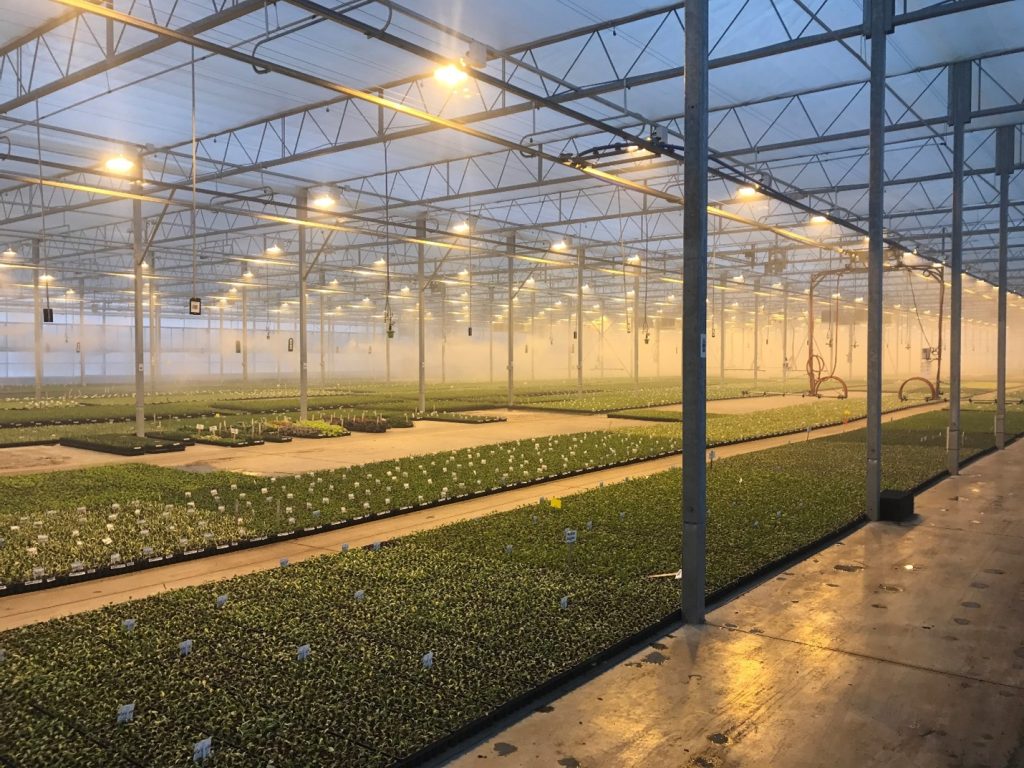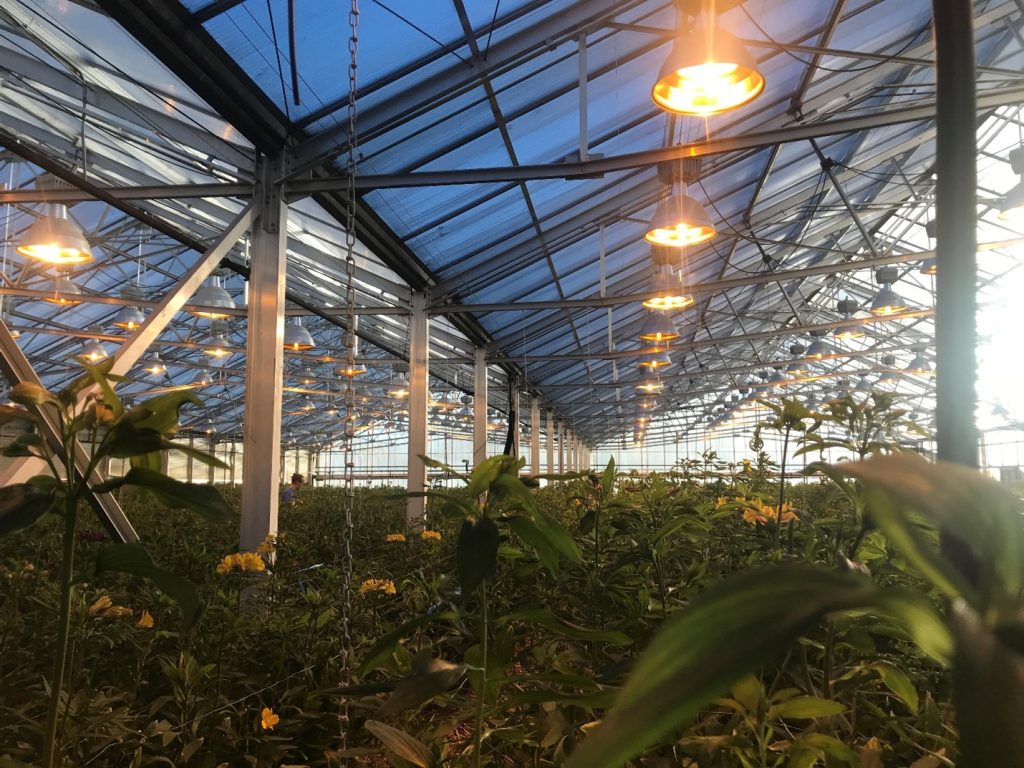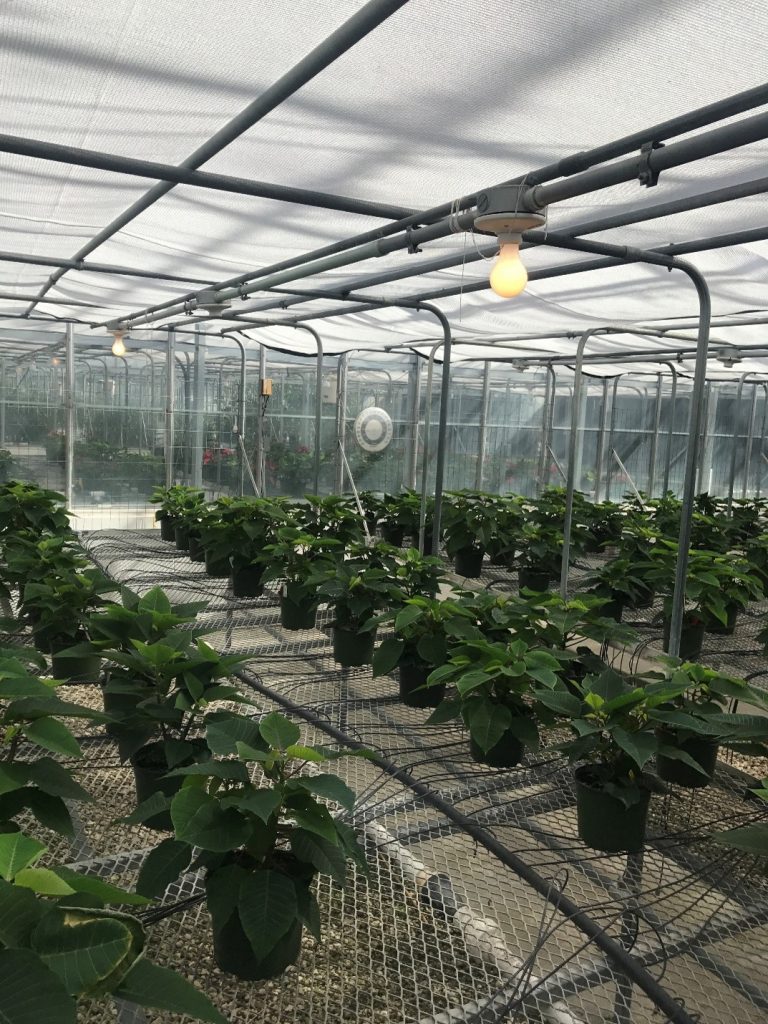Introduction
You may have noticed that the days are getting shorter, which means it’s the opportune time to be introducing plant lighting into your production setting. The topic of lighting can seem very complicated and overwhelming, so this article is meant to highlight two primary strategies for plant lighting and standard lighting terminology used across the industry. Supplemental and photoperiodic lighting play pivotal roles in greenhouse production, shaping the way we cultivate plants and meet market demands. Supplemental lighting provides additional artificial light when sunlight is insufficient, allowing for year-round cultivation, improved crop quality, and enhanced yield potential. Photoperiodic lighting, which regulates day length, offers precise control over vegetative and flowering cycles, enabling growers to synchronize production with market demand. Using plant lighting in your greenhouse is the horticultural equivalent of saying, “lights, camera, action!” and the key to enhancing quality and having greater control over your production schedule.
Supplemental lighting
Supplemental lighting is heavily relied on during times of the year where daily light integral (DLI) is limited, such as in the fall and early spring season, but can also be used year-round to ensure plants meet their light requirement even on the cloudiest of days. Plants use light in the 400-700 nanometer range, otherwise known as photosynthetically active radiation or PAR. To determine how much supplemental lighting your situation calls for, you need to consider your target photosynthetic photon flux density (PPFD), or the intensity of light within the PAR waveband that strikes a surface of one square meter in one second (μmol·m–2·s–1), and the natural sunlight at your location – don’t forget to factor in any potential transmission loss from greenhouse glazing or structure. For the most accurate reading, this measurement can be made with an Apogee quantum sensor at plant height, or for a more general estimate, data can be sourced from the internet.

Figure 1. Grower using supplemental lighting in a greenhouse for young plant production.
Various types of lighting technologies are used for this plant lighting approach including high-pressure sodium (HPS), metal halide (MH), and light-emitting diodes (LEDs). LEDs have gained popularity due to their energy efficiency, longevity, and tunable spectra, allowing growers to customize light conditions for specific plant requirements. Supplemental lighting is an indispensable tool for operations growing ornamental, edible, or medicinal crops, so don’t miss the opportunity to optimize your crop this season.

Figure 2. Grower using LED lights for supplemental lighting on basil production in a greenhouse.

Figure 3. Grower using supplemental lighting inside a greenhouse for flower production.
Photoperiodic lighting
Photoperiodic lighting is a technique that controls the duration and intensity of light exposure to influence various biological and physiological processes in plants. By manipulating the light cycle, growers can extend or shorten the vegetative phase of plants, optimize flowering times, and enhance crop yields. This technique is invaluable for maintaining year-round harvests and improving crop quality. There are 3 different photoperiod response groups – short day, long day, and day-neutral. Furthermore, long and short-day plants can be classified into either facultative or obligate categories. Obligate photoperiod response plants will only flower if their long or short photoperiod is met, while facultative plants will flower quicker with short or long days, or eventually flower regardless of day length. Photoperiodic lighting is typically delivered at 1-2 μmol·m–2·s–1, which is not a high enough intensity for photosynthesis. Therefore, photoperiodic lighting is only used to quicken the flowering of long-day plants and inhibit the flowering of short-day plants – it does not increase growth rate. Photoperiodic lighting can either be applied by extending the natural day length, or by turning lights on for a period during the night (e.g., 10pm to 2am) to reach the optimum photoperiod length. By manipulating the photoperiod, we can coax plants into a synchronized dance with our calendar, ensuring they bloom when we want them to.
GGSPro offers an array of products compatible for use plant lighting applications, including Signify, PL Lights, and Total Gro. For guidance on how to get started with your crop lighting requirement calculation, please feel free to contact GGSPro at ggspro@griffinmail.com. Griffin’s Construction Department is also here to help you determine the lighting technology and design you need to maximize profits based on your budget and production goals.

Figure 4. Grower using low intensity light for photoperiodic lighting with Poinsettias.
You may have noticed that the days are getting shorter, which means it’s the opportune time to be introducing plant lighting into your production setting. The topic of lighting can seem very complicated and overwhelming, so this article is meant to highlight two primary strategies for plant lighting and standard lighting terminology used across the industry. Supplemental and photoperiodic lighting play pivotal roles in greenhouse production, shaping the way we cultivate plants and meet market demands. Supplemental lighting provides additional artificial light when sunlight is insufficient, allowing for year-round cultivation, improved crop quality, and enhanced yield potential. Photoperiodic lighting, which regulates day length, offers precise control over vegetative and flowering cycles, enabling growers to synchronize production with market demand. Using plant lighting in your greenhouse is the horticultural equivalent of saying, “lights, camera, action!” and the key to enhancing quality and having greater control over your production schedule.
Supplemental lighting
Supplemental lighting is heavily relied on during times of the year where daily light integral (DLI) is limited, such as in the fall and early spring season, but can also be used year-round to ensure plants meet their light requirement even on the cloudiest of days. Plants use light in the 400-700 nanometer range, otherwise known as photosynthetically active radiation or PAR. To determine how much supplemental lighting your situation calls for, you need to consider your target photosynthetic photon flux density (PPFD), or the intensity of light within the PAR waveband that strikes a surface of one square meter in one second (μmol·m–2·s–1), and the natural sunlight at your location – don’t forget to factor in any potential transmission loss from greenhouse glazing or structure. For the most accurate reading, this measurement can be made with an Apogee quantum sensor at plant height, or for a more general estimate, data can be sourced from the internet.

Figure 1. Grower using supplemental lighting in a greenhouse for young plant production.
Various types of lighting technologies are used for this plant lighting approach including high-pressure sodium (HPS), metal halide (MH), and light-emitting diodes (LEDs). LEDs have gained popularity due to their energy efficiency, longevity, and tunable spectra, allowing growers to customize light conditions for specific plant requirements. Supplemental lighting is an indispensable tool for operations growing ornamental, edible, or medicinal crops, so don’t miss the opportunity to optimize your crop this season.

Figure 2. Grower using LED lights for supplemental lighting on basil production in a greenhouse.

Figure 3. Grower using supplemental lighting inside a greenhouse for flower production.
Photoperiodic lighting
Photoperiodic lighting is a technique that controls the duration and intensity of light exposure to influence various biological and physiological processes in plants. By manipulating the light cycle, growers can extend or shorten the vegetative phase of plants, optimize flowering times, and enhance crop yields. This technique is invaluable for maintaining year-round harvests and improving crop quality. There are 3 different photoperiod response groups – short day, long day, and day-neutral. Furthermore, long and short-day plants can be classified into either facultative or obligate categories. Obligate photoperiod response plants will only flower if their long or short photoperiod is met, while facultative plants will flower quicker with short or long days, or eventually flower regardless of day length. Photoperiodic lighting is typically delivered at 1-2 μmol·m–2·s–1, which is not a high enough intensity for photosynthesis. Therefore, photoperiodic lighting is only used to quicken the flowering of long-day plants and inhibit the flowering of short-day plants – it does not increase growth rate. Photoperiodic lighting can either be applied by extending the natural day length, or by turning lights on for a period during the night (e.g., 10pm to 2am) to reach the optimum photoperiod length. By manipulating the photoperiod, we can coax plants into a synchronized dance with our calendar, ensuring they bloom when we want them to.
GGSPro offers an array of products compatible for use plant lighting applications, including Signify, PL Lights, and Total Gro. For guidance on how to get started with your crop lighting requirement calculation, please feel free to contact GGSPro at ggspro@griffinmail.com. Griffin’s Construction Department is also here to help you determine the lighting technology and design you need to maximize profits based on your budget and production goals.

Figure 4. Grower using low intensity light for photoperiodic lighting with Poinsettias.
| Products | Item # |
|---|---|
| Apogee Instr. DLI-400 Light Meter (Sunlight Only) | 83-2800 |
| Apogee Instr. DLI-500 Light Meter (Outdoor or Indoor) | 83-2801 |
| Apogee Instr. DLI-600 Light Meter (ePAR) | 83-2802 |